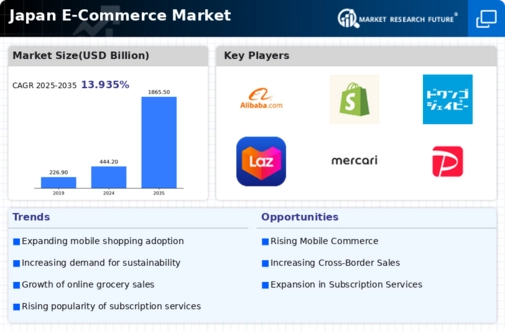Growth of Online Retail Platforms
The e commerce market in Japan is witnessing a significant expansion of online retail platforms, which are increasingly catering to diverse consumer needs. Major players in the industry are investing heavily in user experience enhancements, leading to a reported 25% increase in online shopping frequency among consumers. This growth is further fueled by the rise of niche marketplaces that focus on specific product categories, allowing for a more personalized shopping experience. As competition intensifies, retailers are likely to adopt innovative strategies to attract and retain customers, thereby driving further growth in the e commerce market.
Impact of Social Media Marketing Strategies
The e-commerce sector in Japan is increasingly shaped by the strategic use of social media marketing. Brands are leveraging platforms such as Instagram and Twitter to engage with consumers, resulting in a reported 40% increase in online sales attributed to social media campaigns. This trend highlights the importance of building brand awareness and fostering customer relationships through digital channels. As social media continues to evolve, its role in influencing purchasing decisions is likely to grow, prompting businesses to invest more in targeted advertising and influencer partnerships. The integration of social media into marketing strategies is expected to be a key driver of growth in the e commerce market.
Technological Advancements in Payment Systems
The e commerce market in Japan is experiencing a notable transformation due to advancements in payment technologies. The integration of digital wallets and contactless payment options has surged, with a reported increase of 30% in mobile payment transactions over the past year. This shift not only enhances consumer convenience but also encourages higher spending, as customers are more likely to complete purchases when payment processes are streamlined. Furthermore, the rise of biometric authentication methods is expected to bolster security, thereby increasing consumer trust in online transactions. As these technologies continue to evolve, they are likely to play a pivotal role in shaping the future landscape of the e commerce market.
Changing Consumer Preferences Towards Convenience
The e-commerce sector in Japan is significantly influenced by shifting consumer preferences that prioritize convenience and efficiency. A recent survey indicates that 70% of consumers prefer online shopping due to its time-saving benefits. This trend is prompting retailers to enhance their logistics and delivery services, with many offering same-day or next-day delivery options. As consumers increasingly seek hassle-free shopping experiences, businesses that adapt to these preferences are likely to thrive. The emphasis on convenience is expected to drive further innovation within the e commerce market, as companies strive to meet the evolving demands of their customers.
Increased Internet Penetration and Smartphone Usage
Japan's e commerce market is benefiting from the continuous rise in internet penetration and smartphone usage. As of November 2025, approximately 95% of the population has access to the internet, with smartphone ownership reaching around 85%. This widespread connectivity enables consumers to engage with e commerce platforms more readily, leading to an increase in online purchases. The convenience of shopping from mobile devices is likely to encourage impulsive buying behaviors, further propelling the growth of the e commerce market. As technology continues to advance, the potential for innovative shopping experiences will likely expand, attracting even more consumers.






















Leave a Comment